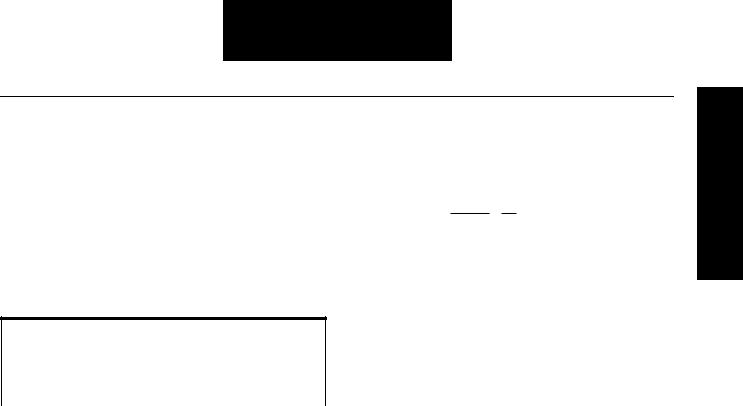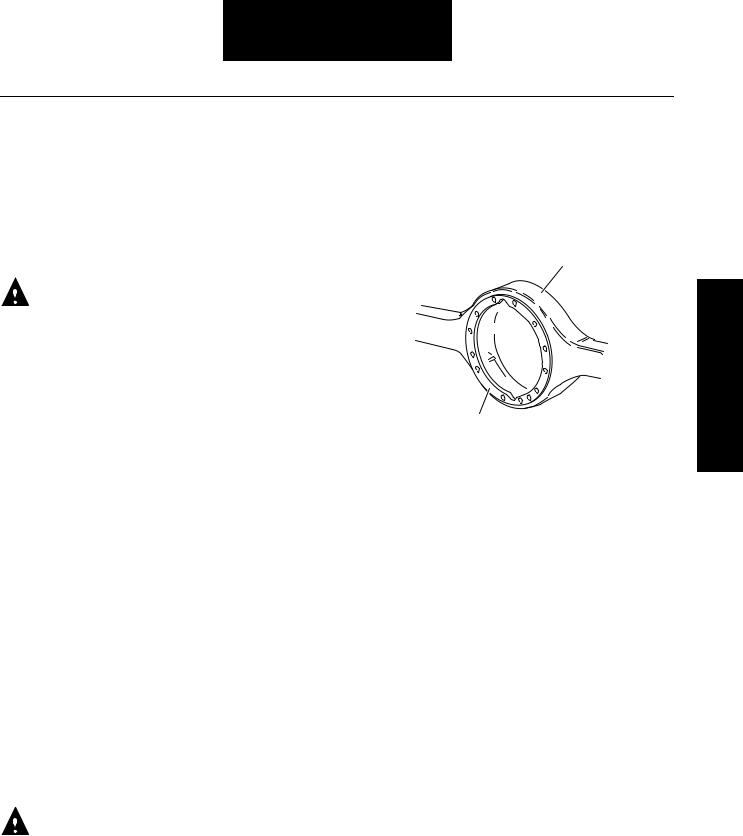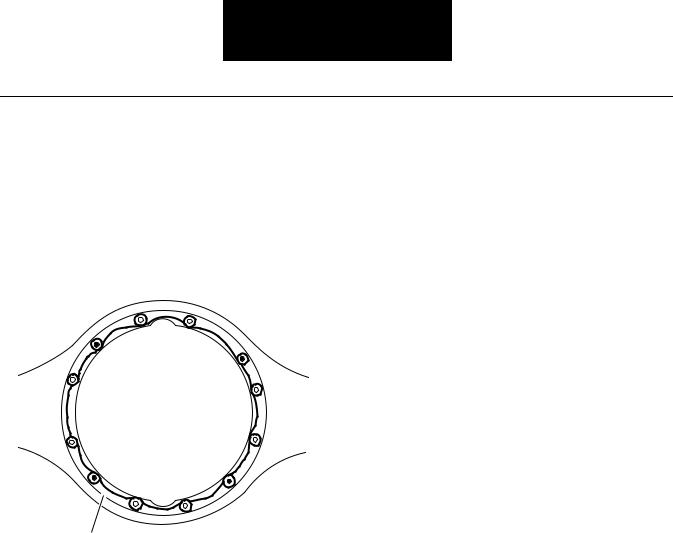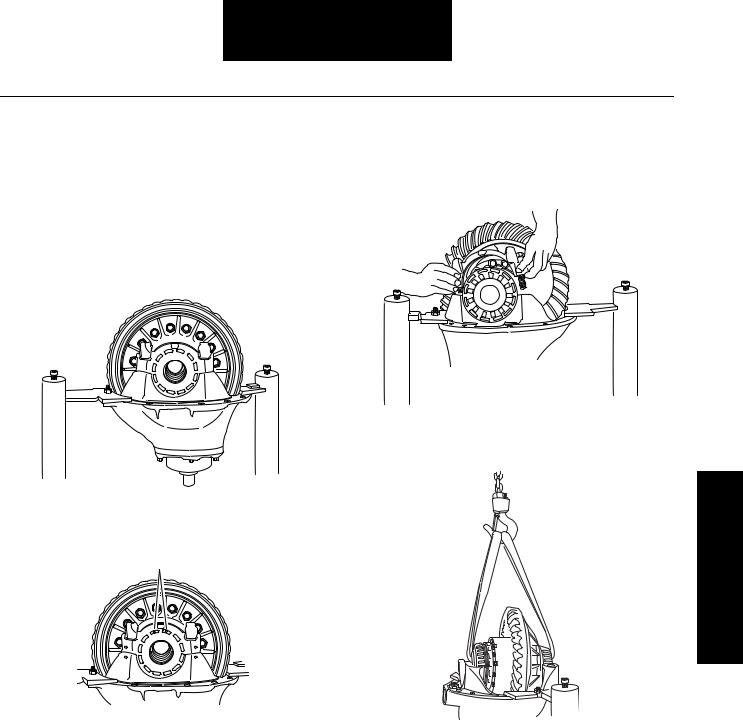Spicer S135L, S135N, S135S, S150L, S150N User Manual
...
Spicer® Single Drive Axles
Service Manual
Spicer® Drive Axles
AXSM-8941
September 2007

General Information
General Information
The description and specifications contained in this service publication are current at the time of printing. Dana Corporation reserves the right to discontinue or to modify its models and/or procedures and to change specifications at any time without notice.
Any reference to brand names in this publication is made simply as an example of the types of tools and materials recommended for use and should not be considered an endorsement. Equivalents, if available, may be used.
Important Notice
This symbol is used throughout this manual to call attention to procedures where carelessness or failure to follow specific instructions may result in personal injury and/or component damage.
Departure from the instructions, choice of tools, materials and recommended parts mentioned in this publication may jeopardize the personal safety of the service technician or vehicle operator.
WARNING:Failure to follow indicated procedures creates a high risk of personal injury to the servicing technician.
CAUTION:Failure to follow indicated procedures may cause component damage or malfunction.
IMPORTANT:Highly recommended procedures for proper service of this unit.
NOTE: Additional service information not covered in the service procedures.
TIP: Helpful removal and installation procedures to aid in the service of this unit.
Always use genuine Dana replacement parts.

Table of Contents
Table of Contents - Visual
Wheel |
Carrier |
Assembly |
|
Differential |
page 8 |
Assembly |
Drive |
|
Pinion |
||
page 17 |
||
page 12 |
||
|
Housing |
Pinion |
|
Seals |
||
Breather |
||
page 12 |
||
page 26 |
||
|
Lubrication page 33
Wheel End Seal page 28
Contents of Table

Table of Contents
Table of Contents
General Information
Introduction . . . . . . . . . . . . . . . . . . . . . . . . . . . . . . . . 1 Model Identification . . . . . . . . . . . . . . . . . . . . . . . . . . 2 Parts Identification. . . . . . . . . . . . . . . . . . . . . . . . 3 Ring Gear and Pinion . . . . . . . . . . . . . . . . . . . . . . . . . 4
Inspection
Failure Analysis . . . . . . . . . . . . . . . . . . . . . . . . . . . . . 5 Prepare the Parts for Inspection . . . . . . . . . . . . . . . . 6 Inspection . . . . . . . . . . . . . . . . . . . . . . . . . . . . . . . . . 7 Clean . . . . . . . . . . . . . . . . . . . . . . . . . . . . . . . . . . 7 Inspect Axle Housing . . . . . . . . . . . . . . . . . . . . . . 7 Inspect Primary Gearing . . . . . . . . . . . . . . . . . . . 7
Differential Carrier Assembly
Differential Carrier Assembly - Exploded View . . . . . . 8 Removal of Differential Carrier From Axle Housing . . 9 Install Differential Carrier . . . . . . . . . . . . . . . . . . . . . 10 Remove Wheel Differential . . . . . . . . . . . . . . . . . . . . 11
Pinion Assembly
Rear Axle Pinion Assembly - Exploded View . . . . . . 12 Remove Pinion Assembly . . . . . . . . . . . . . . . . . . . . 13 Install Pinion Assembly . . . . . . . . . . . . . . . . . . . . . . 15
Wheel Differential Assembly
Wheel Differential Assembly - Exploded View . . . . . 17 Disassemble, Overhaul and
Assemble Wheel Differential . . . . . . . . . . . . . . . . . . 18 Disassemble Wheel Differential . . . . . . . . . . . . . 18 Overhaul and Assemble Wheel Differential. . . . . 20
Wheel Differential Adjustments
Measure and Adjust Carrier Assembly
(Adjust Backlash and Preload) . . . . . . . . . . . . . . . . . 22 Change Backlash Setting . . . . . . . . . . . . . . . . . . . . . 23
Adjust Tooth Contact Pattern |
|
Adjust Ring and Pinion Tooth Contact Pattern . . . . . |
24 |
Adjust Ring Gear Position (Backlash) . . . . . . . . . . . |
25 |
Housing Breather
Install New Axle Housing Breather -
(Metal and Plastic) . . . . . . . . . . . . . . . . . . . . . . . . . . .26
Axle Housing
Axle Housing - Exploded View . . . . . . . . . . . . . . . . . .27
Wheel End Seal
Wheel End Seal Parts - Exploded View . . . . . . . . . . .28 Remove and Overhaul Wheel End Seal . . . . . . . . . . .29 Install Wheel End Seal . . . . . . . . . . . . . . . . . . . . 29
Wheel Adjustment Systems
Adjust Wheel Bearing . . . . . . . . . . . . . . . . . . . . . . . .30
Wheel Ends
Verify Wheel End-Play Procedure . . . . . . . . . . . . . . .32
Lubrication
Lubricate Wheel End . . . . . . . . . . . . . . . . . . . . . . . . .33 General Lubrication Information . . . . . . . . . . . . . . . .35 Approved Lubricants . . . . . . . . . . . . . . . . . . . . . .35
Recommendations for Viscosity/
Ambient Temperature . . . . . . . . . . . . . . . . . . . . 35 Lube Change Intervals . . . . . . . . . . . . . . . . . . . . . . . .36 Change Lube . . . . . . . . . . . . . . . . . . . . . . . . . . . . . . .37 Drain . . . . . . . . . . . . . . . . . . . . . . . . . . . . . . . . . 37 Fill . . . . . . . . . . . . . . . . . . . . . . . . . . . . . . . . . . . 37
Proper Vehicle Towing
With Truetrac Limited Slip Differential. . . . . . . . 38 Torque Flow. . . . . . . . . . . . . . . . . . . . . . . . . . . . .39
Parts Identification |
|
Rear Drive Axle Parts - Exploded View . . . . . . . . . . . |
40 |
Torque Specifications |
|
Fastener Torque Specifications . . . . . . . . . . . . . . . . .41
Service Tools
Recommended Service Tools . . . . . . . . . . . . . . . . . .42

General Information
Introduction
Dana Corporation presents this publication to aid in maintenance and overhaul of Dana single reduction drive axles. Instructions contained cover the models listed below. Their design is common, with differences in load capacity. Capacity variations are achieved by combining basic differential carrier assemblies with different axle housings, axle shafts, and wheel equipment.
Model Listing
The following models are included in this publication:
Dana Single Reduction Axles
With Standard Wheel Differential
S135L |
S135N |
S135S |
|
|
|
S150L |
S150N |
S150S |
|
|
|
|
S 135 S |
||||||
Spicer |
|
|
|
|
|
|
Gearing Type |
|
|
|
|
|
|
||
|
|
|
|
|
|
|
S = Single Reduction |
|
|
|
|
|
|
|
L = True Trac Differential |
|
|
|
|
|
|
|
N = No Spin |
|
|
|
Nominal Load |
||||
|
|
|
Carrying Capacity |
||||
|
|
|
135 = 13,500 lbs. |
||||
|
|
|
150 = 15,500 lbs. |
||||
Information General
1

General Information
Model Identification
2
1
|
|
|
(P) CARRIER # |
360CR100 6X |
|
3
SER # |
SPICER |
3.91 |
94070 |
|
620112 |
RATIO |
R1 4242 |
||
|
4
5
CUST. PART NO. |
Spicer® |
SPEC. |
SERIAL NO. |
MODEL PART NO. RATIO |
|
MADE IN: |
|
1 |
- Customer part number (optional) |
|
|
2 |
- Dana part number |
|
|
3 |
- Julian date code |
|
|
4 |
- Line set number (optional) |
Rear Axle |
|
5 |
- Last six digits of vehicle serial number |
||
|
(optional) |
(Top View) |
|
Data plate is located on the axle centerline
2

General Information
Parts Identification
Axle Housing |
Julian Date Code |
|
|
|
94 070 |
|
Model Year |
Day of Year |
1 |
|
|
|
2 |
|
|
|
|
|
|
|
3 |
|
|
360RF100-6 |
MODEL |
||||
|
|
|
|
|
S135-S |
|
|
|
4 |
|
|
||
|
|
|
|
4 |
||
|
|
|
|
|
||
|
SER # |
RATIO |
94070 |
|
||
620112 |
3.91 |
R1 4242 |
||||
5
6
1 - Dana part number
2 - Customer part number (optional)
3 - Model
4 - Julian date code
5 - Line set number (optional)
6 - Last six digits of vehicle serial number (optional)
Axle Shaft
1
1 - Axle shaft part number
Information General
3

General Information
Ring Gear and Pinion
Manufacturer’s Date - Date gear set was made.
Spicer Trademark - Company logo and location of manufacturing facility.
360GP104 - Part number of pinion gear. (TYPICAL)
Tooth Combination (i.e. 41-11) - Indicates the pinion has 11 teeth and the ring gear has 41 teeth which results in a 3.73:1 ratio.
Matched Set Number - Spicer ring and pinions are manufactured as matched sets. Both ring and pinion are marked with a corresponding number (i.e. 260), which identifies them as a matched set.
A gear set that does not have the same match set numbers should not be mated together. If either ring gear or pinion require replacement, a new matched set must be used.
1
41-11

 260 41-11
260 41-11 
2 |
3 |
4 |
5 |
6 |
7 |
|
|
|
|
|
260
1 |
- Spicer trademark |
5 |
- Spicer trademark |
2 |
- Tooth combination |
6 |
- Manufacturer’s date |
3 |
- Part number |
7 |
- Matched set number |
4 |
- Heat code |
|
|
4

Inspection
Failure Analysis
Failure analysis is the process of determining the original cause of a component failure in order to keep it from happening again. Too often, when a failed component is replaced without determining its cause, there will be a recurring failure. If a carrier housing is opened, revealing a ring gear with a broken tooth, it is not enough to settle on the broken tooth as the cause of the carrier failure. Other parts of the carrier must be examined. For a thorough understanding of the failure and possible insight into related problems, the technician needs to observe the overall condition of the vehicle.
No one benefits when a failed component goes on the junk pile with the cause unknown. Nothing is more disturbing to a customer than a repeat failure. Systematically analyzing a failure to prevent a repeat occurrence assures quality service by avoiding unnecessary downtime and further expense to the customer.
The true cause of a failure can be better determined by knowing what to look for, determining how a piece of the equipment was running and learning about previous problems. In the case of a rebuilt rear axle, mismatched gears may have been installed.
The more successful shops prevent repeat equipment failures by developing good failure analysis practices. Knowing how to diagnose the cause of a premature failure is one of the prerequisites of a good heavy-equipment technician.
How to Diagnose a Failure
The following five steps are an effective approach to good failure diagnostics:
1.Document the problem.
2.Make a preliminary investigation.
3.Prepare the parts for inspection.
4.Find the cause of the failure
5.Correct the cause of the problem.
Document the Problem
Here are some guidelines for starting to learn about a failure, including questions to ask:
•Talk to the operator of the truck.
•Look at the service records.
•Find out when the truck was last serviced.
•Ask: In what type of service is the truck being used?
•Ask: Has this particular failure occurred before?
•Ask: How was the truck working prior to the failure?
You need to be a good listener. Sometimes, insignificant or unrelated symptoms can point to the cause of the failure.
•Ask: Was the vehicle operating at normal temperatures?
•Ask: Were the gauges showing normal ranges of operation?
•Ask: Was there any unusual noise or vibration?
After listening, review the previous repair and maintenance records. If there is more than one driver, talk to all of them and compare their observations for consistency with the service and maintenance records. Verify the chassis Vehicle Identification Number (VIN) number from the vehicle identification plate, as well as the mileage and hours on the vehicle.
Make a Preliminary Investigation
These steps consist of external inspections and observations that will be valuable when combined with the results of the parts examination.
•Look for leaks, cracks, or other damage that can point to the cause of the failure.
•Make note of obvious leaks around plugs and seals. A missing fill or drain plug would be an obvious cause for concern.
•Look for cracks in the carrier housing (harder to see, but sometimes visible).
•Does the general mechanical condition of the vehicle indicate proper maintenance or are there signs of neglect?
•Are the tires in good condition and do the sizes match?
•If equipped with a torque-limiting device, is it working properly?
During the preliminary investigation, write down anything out of the ordinary for later reference. Items that appear insignificant now may take on more importance when the subassemblies are torn down.
Inspection
5

Inspection
Prepare the Parts for Inspection
After the preliminary investigation, locate the failure and prepare the part for examination. In carrier failure analysis, it may be necessary to disassemble the unit.
•When disassembling subassemblies and parts, do not clean the parts immediately since cleaning may destroy some of the evidence.
Find the Cause of the Failure
Here begins the real challenge to determine the exact cause of the failure. Keep in mind that there is no benefit to replacing a failed part without determining the cause of the failure. For example, after examining a failed part and finding that the failure is caused by a lack of lubrication, you must determine if there was an external leak. Obviously, if there is an external
•When tearing down the drive axle, do it in the recomleak, just replacing the failed gear is not going to correct the
mended manner. Minimize any further damage to the unit.
•Ask more questions when examining the interior of the carrier. Does the lubricant meet the manufacturer specifications regarding quality, quantity, and viscosity? As soon as you have located the failed part, take time to analyze the data.
situation.
Another important consideration here is to determine the specific type of failure which can be a valuable indicator for the cause of failure. The following pages show different types of failures and possible causes. Use this as a guide in determining types of failures and in correcting problems.
Correct the Cause of the Problem
Once the cause of the problem has been determined, refer to the appropriate service manual to perform the repairs.
6

Inspection
Inspection
Clean
1.Wash steel parts with ground or polished surfaces in solvent. There are many suitable commercial solvents available. Kerosene and diesel fuel are acceptable.
WARNING: Gasoline is not an acceptable solvent because of its extreme combustibility. It is unsafe in the workshop environment.
2.Wash castings or other rough parts in solvent or clean in hot solution tanks using mild alkali solutions.
Note: If a hot solution tank is used, make sure parts are heated thoroughly before rinsing.
3.Rinse thoroughly to remove all traces of the cleaning solution.
4.Dry parts immediately with clean rags.
5.Oil parts.
•If parts are to be reused immediately: Lightly oil.
•If parts are to be stored: Coat with oil, wrap in corrosion resistant paper and store in a clean, dry place.
Inspect Axle Housing
Axle housing inspection and repairs are limited to the following checks or repairs:
•Visually inspect axle housing for cracks, nicks and burrs on machined surfaces.
•Check carrier bolt holes and studs for foreign material.
•Replace damaged fasteners. Look for loose studs or cross threaded holes.
CAUTION: Any damage which affects the alignment or structural integrity of the housing requires housing replacement. Do not repair by bending or straightening. This process can affect the material’s properties and cause it to fail completely under load.
•Check all seals and gaskets.
Note: Replace conventional gaskets with silicone rubber gasket compound (included in many repair kits). The compound provides a more effective seal against lube seepage and is easier to remove from mating surfaces when replacing parts.
1
2
1 - Axle Housing
2 - Machined Surface
Inspect all steel parts for:
•Notches, visible steps or grooves created by wear.
•Pitting or cracking along gear contact lines.
•Scuffing, deformation, or discolorations. These are signs of excessive heat in the axle and are usually related to low lubrication levels or improper lubrication practices.
In addition, inspect the following for damage:
•Differential gearing.
•Bearings for loose fit on drive pinion, pilot bearing, and differential bearings.
•All fasteners for rounded heads, bends, cracks or damaged threads.
•Inspect machined surfaces of cast or malleable parts. They must be free of nicks, burrs, cracks, scoring, and wear.
•Look for elongation of drilled holes, wear on surfaces machined for bearing fits and nicks or burrs in mating surfaces.
Inspect Primary Gearing
Before reusing a primary gear set, inspect teeth for signs of excessive wear. Check tooth contact pattern for evidence of incorrect adjustment.
Inspection
7

Differential Carrier
Differential Carrier Assembly - Exploded View
1
3
2
1 - Carrier fasteners
2 - Carrier assembly
3 - Single axle assembly
8

Differential Carrier
Removal of Differential Carrier From Axle Housing
1.Block wheels.
2.Remove axle housing drain plug and drain lubricant.
3.Disconnect drive shafts at the rear U-joint.
Note: If end yoke and/or seal is to be replaced, loosen yoke nut at this time.
4.Remove axle shaft flange nuts.
5.Hold a large brass drift or a brass hammer against the center of the axle shaft flange. Strike the drift with a large hammer or sledge until the axle shaft separates from the hub.
CAUTION: Do not strike the flange directly with a steel hammer or sledge. This may crack and splinter material, possibly causing serious or fatal injury. Do not pry or chisel axle flange away from hub; damage to sealing surfaces could occur.
6.Remove axle shafts.
7.Support the differential carrier assembly on a roller jack. Secure as necessary to prevent it from falling off the jack when removed from the housing.
8.Loosen all but the top two carrier-to-housing mounting bolts. Remove all bolts except the top two. These two bolts will prevent the carrier assembly from falling.
9.Separate the differential carrier from the housing using the removal slots. Make sure the carrier is balanced properly on jack. Remove the top two carrier mounting bolts. Remove the differential carrier assembly from the axle housing.
1
1

1- Removal slots
10.Mount carrier assembly in a suitable rebuild stand.
Carrier Differential
9

Differential Carrier
Install Differential Carrier
IMPORTANT: Before installing the carrier assembly, inspect and thoroughly clean interior of axle housing using an appropriate solvent and clean rag.
1.Apply Dana approved RTV compound on axle housing mating surface as shown in the illustration. Completely remove all old gasket material prior to applying new material. Compound will set in 20 minutes. Install carrier before compound sets or reapply.
1
1 - Apply silicone gasket in this pattern
TIP: To assist in installing complete differential carrier use two pieces of threaded rod threaded into carrier cap screw holes. Rod should be approximately 6" long. Use these to pilot the carrier into the housing.
2.Install carrier to housing, washers, cap screws, and nuts. Torque to proper specifications. See torque chart of page 41.
3.Install axle shafts and axle stud nuts (if used, also install lock washers and tapered dowels).
4.Add axle lubricant. Fill to the bottom of the fill hole.
5.Connect inter-axle driveline, making sure all yokes are in phase. Lubricate U-joints.
10

Differential Carrier
Remove Wheel Differential - All Standard Models
1.Mount differential carrier in repair stand.
Note: Omit this step if the gear set is to be replaced. If gear set is to be reused, check tooth contact pattern and ring gear backlash before disassembling differential carrier. When checking backlash, a yoke or helical gear must be installed and torqued to get an accurate reading. Best results are obtained when established wear patterns are maintained in used gearing.
2.If reusing gear set, also punch mark bearing adjusters for reference during assembly.
3.Remove cap screws, flat washers, and bearing caps. Loosen bearing adjusters and remove adjusters and bearing cups.
4.Using a chain hoist, lift ring gear and differential assembly out of carrier.
1
Carrier Differential
11
